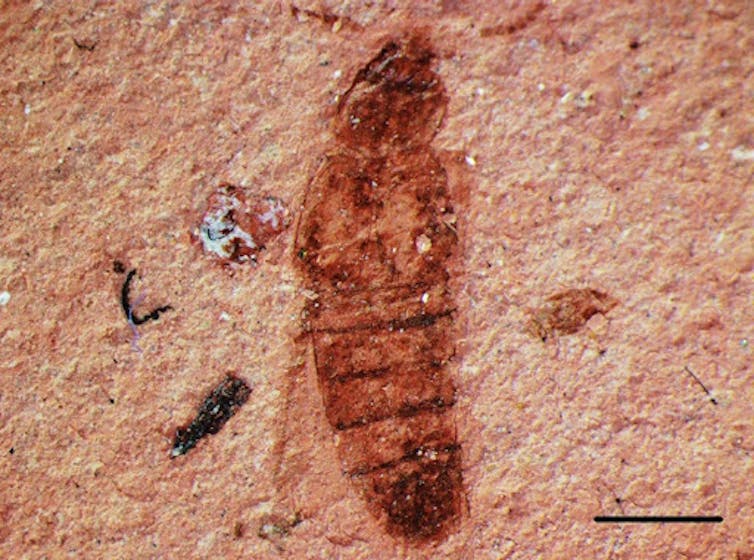When I tell people that I study fossils, many assume I am talking about dinosaurs or some equally impressive extinct creatures. But there’s far more to be found in the global fossil record, like plants, fish and insects.
Researchers who study fossil insects preserved in rock or amber deposits are called palaeoentomologists – and I’m one of very few in the world. (I’d estimate there are roughly 200, many of them still studying towards PhDs and not yet working full-time.) I’m also the first and only black South African in the field.
By studying the remains of fossil insects such as beetles, aphids, thrips and plant lice that lived millions of years ago, this tiny community of palaeonentomologists is helping to build a more complete picture of life on our planet in the distant past.
For instance, working in southern Africa, my colleagues and I recently discovered two new species of rove beetles preserved in sediments from Orapa Diamond Mine, a rock deposit in Botswana. This brings the total of new rove beetle species emerging from Orapa to four, as we discovered two others since 2022.
These are the first-of-their-kind fossil rove beetles ever discovered in Africa and in the southern hemisphere more broadly. They tell us that rove beetles have remained largely unchanged over a long evolutionary period. And they paint a picture of what the mine looked like long ago: leaf litter, logs, debris and continuous vegetation in and around a crater lake that existed at the time.
Read more: Fossil beetles found in a Botswana diamond mine help us to reconstruct the distant past
But, until about 15 years ago, I had never thought about studying insects – living or fossilised. It took a twist of academic fate, a brilliant introductory lecture and an amazing mentor to start me on a journey of exploring insects. I now get to study and name fossil insects.
One of the most exciting and fulfilling things in my life has been uncovering some of the ancient insect treasures emerging from Orapa Diamond Mine, which is near Botswana’s second biggest city, Francistown. I have since decided to make this my lifelong commitment and my hope is that this story will inspire future palaeoentomologists.
Insects and ecosystems
When I finished school in South Africa’s Eastern Cape province, I wanted to study medicine. I applied to two universities; one never responded and the other explained that, because I hadn’t completed a required test, starting a medical degree was out of the question that year. Why not pursue another degree instead of waiting a whole year to apply again?, the administrators suggested.
My second choice, Biological Sciences, was also full at the time, and the nearest equivalent to it was a degree called Pest Management. I signed up for it. In our very first lecture as undergraduates, we were taught about the many important ecosystem services that insects provide. They form an integral part of food webs by converting plant and algal biomass into animal biomass.
Read more: Conservation efforts must include small animals. After all, they run the world
Some are eaten by humans. They regulate prey populations. They recycle energy and nutrients. They predict time of death of a corpse. And they’re bio-indicators – organisms that are a sign of the health of ecosystems. Unhealthy ecosystems tend to have low species richness, diversity and abundance.
Read more: Eating insects has long made sense in Africa. The world must catch up
I was blown away by this. I’d never given insects much thought. Now I wanted to study them for the rest of my life. So I did, focusing on living insects during my undergraduate, Honours and Masters degrees, first researching the marula fruit fly, which is a crop pest of fruit, and then mirid bugs, which are used as biological control agents for an invasive alien plant called water hyacinth.
Focusing on fossils
In 2018, I realised that I loved living insects more than ever but needed a new challenge in a new environment. That’s when I discovered that no one in South Africa was actively studying fossilised insects, and I set off on a new path.
My PhD was supervised by Dr Ian James McKay, a geoscience outreach specialist at the University of the Witwatersrand in Johannesburg who had previously studied fossil insects (specifically ground beetles) from the Orapa deposit. With his guidance and support, I became a Doctor of Science in Palaeontology. It was a bittersweet honour to name one of the four new species of rove beetles after him as Paleothius mckayi after he passed away in 2022.

Today, sadly, I remain one of the few palaeoentomologists in Africa and globally. Hopefully that will change in the coming years. The continent is rich in all sorts of fossils, more and more of which are being exposed by soil erosion. New insect treasures are almost certainly just waiting to be found.
Key skills
If this all sounds like something that might appeal to you as you mull a future career, there are a few things you need to know.
Palaeoentomologists need several key skills. You have to be patient: it takes time and care to collect fossils without destroying them. A keen eye is crucial, because fossil insects can be easily mistaken as useless pieces of rocks or other debris, and discarded. It also helps if you can draw, since we are often required to sketch our finds for better interpretation.
Of course, those skills alone aren’t enough to make you a great fossil insect hunter. You’ll also need a solid background in entomology, as well as taxonomy and systematics, which is a branch of science that deals with identification, description, naming and classification of organisms.

